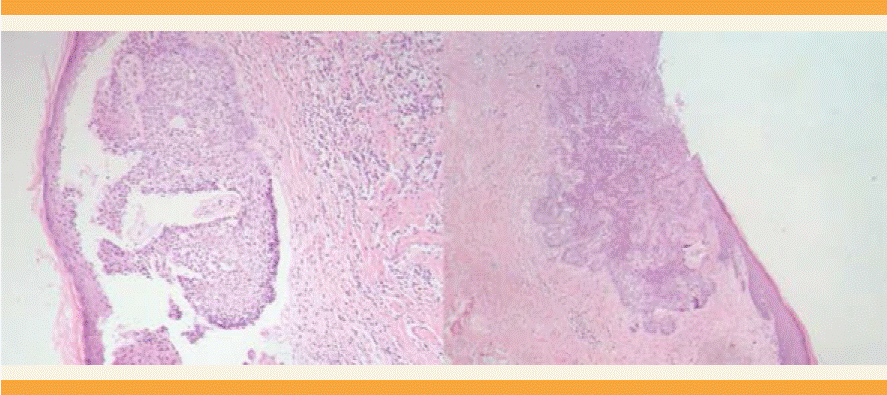Background
Basal cell carcinoma is the most common skin malignancy, representing 75% of non-melanoma skin cancers. It occurs most frequently in men.1 Chronic sun exposure is the main related in ducer, which explains the increased incidence in individuals of more advanced age.2 It generally develops in people with light-colored skin and in locations that are exposed to sunlight. However, basal cell carcinoma may also affect regions that are relatively protected from sunlight such as the armpits, legs, groin and sites that are totally covered such as the perianal and genital regions.2 Vulvar location is extremely rare corresponding to approximately 2-3% of all vulvar carcinomas and less than 1% of all basal cell carcinomas.3
Case report
An 82-year old female hypertensive patient, with a surgical history of right leg amputation due to deep venous thrombosis four years ago, perineoplasty and cardiac catheterization sought medical care.
The patient reported the appearance of a vulvar mass one year previously, that increased in size and exhibited ulceration. On physical examination, the patient had a lesion with elevated borders and central ulceration on the vulva, near the right side of the clitoris, measuring 2 x 2 cm (Figure 1 ), without any suspicious inguinal lymph nodes on physical examination and ultrasonography of the inguinal region. Chest X-ray was normal. Complete blood count and serum biochemical tests showed no alterations. The patient chose to resect the lesion in a one-step approach, without previous biopsy. Excision of the lesion with safety margins was performed (Figures 2, 3). Microscopic analysis showed a malignant ulcerated epithelial tumor composed of atypical basaloid cells with peripheral palisading and occasional artifactual cleft between the tissue blocks and stroma. In the adjacent dermis, a mild nonspecific chronic inflammatory infiltration was observed, demonstrating that it was a basal cell carcinoma of solid ulcerated type, with free lateral and deep surgical margins (Figure 4).

Figure 4 Microscopy: (100 x, hematoxylin and eosin) epithelial tumor composed of atypical basaloid cells with peripheral palisading and occasional artifactual cleft between the tissue blocks and stroma. In the adjacent dermis, a mild nonspecific chronic inflammatory infiltration.
The patient remains asymptomatic without signs of local recurrence or metastases 24 months after surgery. She signed a consent term for permission to publish the case.
Discussion
Basal cell carcinoma is the most common malignancy in humans, particularly in individuals with light-colored skin. Exposure to ultraviolet radiation is the main risk factor associated with the origin of this cancer. There is evidence that these tumors have a higher occurrence in exposed areas, normally the skin of the head and neck.3,4 Other associated factors include exposure to chemical factors such as arsenic, alterations in immunologic vigilance, and some hereditary skin conditions, including Gorlin's syndrome and xeroderma pigmentosum.5 CBC on non-exposed skin, including the armpits, groin, buttocks, vulva, scrotum, penis, perianal and pubic skin is uncommon.3
Basal cell carcinoma of the vulva is a rare occurrence, corresponding to approximately 2-3% of all vulvar carcinomas and less than 1% of all basal cell carcinomas.2 It was first described by Temesvary in 1926. Since that time, few cases have been reported in the literature.1 Despite the frequent association between basal cell carcinoma and ultraviolet radiation and sunlight, it does not provide a plausible explanation for the vulvar lesions. Previous irradiation, syphilis and chronic irritation have been considered possible causes. Other factors may also be involved, such as genetic predisposition, traumas, chronic ulcers, burns, scars and states of systemic im-munosuppression.2 None of these factors was identified in the current case.
In the majority of cases, basal cell carcinoma of the vulva occurs in postmenopausal women and usually presents as an asymptomatic lesion. However, itching, pain, bleeding and a sensation of a lump may occur.2 There may be a delay in diagnosis. Patients may delay seeking medical attention, and consider the pruritus a simple irritation, or physicians may initially misdiagnose these lesions, classifying them as inflammatory or infectious dermatosis. Basal cell carcinoma has a harmless appearance in this region, therefore biopsy of all suspicious lesions is recommended.6 In the present case, the patient chose surgical resection due to the high index of clinical suspicion. She desired to undergo the surgical procedure in a one-step approach.
Basal cell carcinoma of the vulva is mainly located in the labia majora region, although some cases have already been described in the labia minora and clitoris. In general, the lesion is unilateral.2 This pathology shows a high capacity to infiltrate and cause local destruction with a recurrence rate of up to 20%, dependent upon histological type, tumor size and treatment chosen. The rate of metastasis is rare, estimated at around 0.0028%.7
The present clinical case corroborates results showing that the majority of lesions affect women over 70 years of age and behave in an indolent manner with a low propensity for lymphatic spread or distant metastases.8 A wide local excision with free margins is the treatment of choice. In patients who develop larger tumors and lymphatic dissemination, lymphadenectomy must be performed.9
When surgery is contraindicated other treatments may be used, such as curettage, electrocoagulation, cryotherapy, radiation, CO2 laser, photodynamic therapy or topical application of imiquimod.9
This malignancy has a favorable prognosis. Nevertheless, the rate of local recurrence is around 25%. Appropriate patient follow-up is mandatory with frequent physical examination and instructions about the symptoms and signs compatible with tumor recurrence.9











 nueva página del texto (beta)
nueva página del texto (beta)





